Resonance and Air Columns - Complete Toolkit
Objectives
- To describe how one object that vibrates at the same natural frequency of another object can force that second object into resonant vibrations and to identify and discuss several examples of such resonance phenomenon.
- To associate a resonating object with a standing wave pattern and to examine such patterns and identify their nodes and antinodes.
- To define fundamental frequency and to mathematically relate the fundamental frequency to the frequency of the various harmonics of a vibrating object.
- To draw the standing wave patterns for the various harmonics of an open-end and a closed-end air column and to relate the length of the column to the wavelength of the standing wave patterns.
- To use the speed-wavelength-frequency relationship to mathematically analyze a standing wave situation and relate the frequency of the harmonic to the length of the air column and the speed of sound waves within the air column.
Readings from The Physics Classroom Tutorial
- The Physics Classroom Tutorial, Sound Waves and Music Chapter, Lesson 4
- The Physics Classroom Tutorial, Sound Waves and Music Chapter, Lesson 5
Interactive Simulations
- Standing Wave Maker
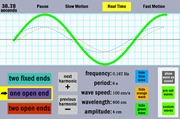 The Standing Wave Maker at The Physics Classroom allows a learner to explore standing waves on strings and air columns. The simulation models both the transverse wave motion and the longitudinal wave motion (select Show Wave as Sound). Learners can explore by building a Custom Wave - that is, by selecting a frequency and amplitude. Or they can select from among the Pre-Set Waves; such pre-set waves include waves for strings (two fixed ends) and waves for open-end and closed-end air columns. The harmonic number can easily be modified. The simulation shows the motion of the two component waves that make up the standing wave pattern and shows the resulting standing wave; all visuals can be toggled on and off.
The Standing Wave Maker at The Physics Classroom allows a learner to explore standing waves on strings and air columns. The simulation models both the transverse wave motion and the longitudinal wave motion (select Show Wave as Sound). Learners can explore by building a Custom Wave - that is, by selecting a frequency and amplitude. Or they can select from among the Pre-Set Waves; such pre-set waves include waves for strings (two fixed ends) and waves for open-end and closed-end air columns. The harmonic number can easily be modified. The simulation shows the motion of the two component waves that make up the standing wave pattern and shows the resulting standing wave; all visuals can be toggled on and off.
- Measuring the Speed of Sound
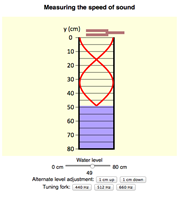 Physics professor Andrew Duffy has put together an exceptional collection of HTML5 simulations that are very suitable for high school students. This simulation will remind teachers of the resonance tube lab often used to determine the speed of sound. The simulation would make an excellent pre-cursor to such a hands-on experience or could serve as a stand-alone activity. Students can select a tuning fork frequency, and adjust the air column length until they observe the strongest standing wave pattern. The simulation shows the air column with the water forming the closed end; the standing wave pattern is drawn inside the air column.
Physics professor Andrew Duffy has put together an exceptional collection of HTML5 simulations that are very suitable for high school students. This simulation will remind teachers of the resonance tube lab often used to determine the speed of sound. The simulation would make an excellent pre-cursor to such a hands-on experience or could serve as a stand-alone activity. Students can select a tuning fork frequency, and adjust the air column length until they observe the strongest standing wave pattern. The simulation shows the air column with the water forming the closed end; the standing wave pattern is drawn inside the air column.
- Longitudinal Standing Wave
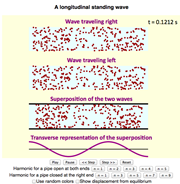 This simulation by Physics professor Andrew Duffy shows the vibrational motion of the air particles for a longitudinal standing wave in an air column. The motion of both the rightward- and the leftward-moving waves are shown along with the superposition of these motions and a transverse representation of the standing wave. Learners can alter the harmonic number to view the patterns for the first five harmonics. They can also choose from among open-end and closed-end air columns. The final option involves showing the displacement of the particles as they vibrate along their back-and-forth path over the course of each cycle.
This simulation by Physics professor Andrew Duffy shows the vibrational motion of the air particles for a longitudinal standing wave in an air column. The motion of both the rightward- and the leftward-moving waves are shown along with the superposition of these motions and a transverse representation of the standing wave. Learners can alter the harmonic number to view the patterns for the first five harmonics. They can also choose from among open-end and closed-end air columns. The final option involves showing the displacement of the particles as they vibrate along their back-and-forth path over the course of each cycle.
- Forced Oscillations and Resonance
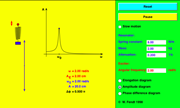 Walter Fendt has been around for a long time producing Java simulations that highlight physics concepts and mathematical relationships. And now much of his work has been and is being rewritten in HTML5, allowing users of mobile devices, iPads, and Chromebooks to enjoy great interactive experiences. In this resonance simulation, students adjusting the frequency of a forced vibration until it matches the natural frequency of a vibrating spring. Once there is a match, resonance occurs. Students can observe the importance of matching the frequency of forced vibration to the natural frequency of the vibrating object.
Walter Fendt has been around for a long time producing Java simulations that highlight physics concepts and mathematical relationships. And now much of his work has been and is being rewritten in HTML5, allowing users of mobile devices, iPads, and Chromebooks to enjoy great interactive experiences. In this resonance simulation, students adjusting the frequency of a forced vibration until it matches the natural frequency of a vibrating spring. Once there is a match, resonance occurs. Students can observe the importance of matching the frequency of forced vibration to the natural frequency of the vibrating object.
- Standing Longitudinal Wave
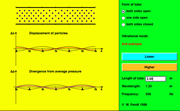 This HTML5 simulation show the various harmonics produced in an open- and a closed-end air column. The standing wave patterns are shown and the nodal and antinodal positions are marked. The back-and-forth vibration of the particles along the column are shown. Buttons allow one to change the harmonic to a different harmonic. The second harmonic is referred to as the first overtone; the third harmonic is referred to as the second overtone and so forth. Learners can enter the length of the air column and the wavelength and frequency are displayed on-screen.
This HTML5 simulation show the various harmonics produced in an open- and a closed-end air column. The standing wave patterns are shown and the nodal and antinodal positions are marked. The back-and-forth vibration of the particles along the column are shown. Buttons allow one to change the harmonic to a different harmonic. The second harmonic is referred to as the first overtone; the third harmonic is referred to as the second overtone and so forth. Learners can enter the length of the air column and the wavelength and frequency are displayed on-screen.
Video and Animations
- Resonance of Sound
 Physics Professor and author of the Conceptual Physics textbook series explains the concept of resonance. Dr. Hewitt explains the concepts of natural frequency, harmonics, and resonance. Numerous illustrations and examples of resonance are given. Such examples include tuning forks, vibrating springs, ocean waves, lasers, and the Tacoma Narrows bridge collapse. Professor Hewitt's typical clear style of communication makes the video understandable for any high school physics student.
Physics Professor and author of the Conceptual Physics textbook series explains the concept of resonance. Dr. Hewitt explains the concepts of natural frequency, harmonics, and resonance. Numerous illustrations and examples of resonance are given. Such examples include tuning forks, vibrating springs, ocean waves, lasers, and the Tacoma Narrows bridge collapse. Professor Hewitt's typical clear style of communication makes the video understandable for any high school physics student.
- Standing Sound Waves
 James Lincoln of AAPT Films provides numerous ideas for demonstrations and instruction on the topic of standing waves produced by interfering sound waves. Each demonstration is described and the physics principles are explained. The video provides a perfect lesson for those teachers new to Physics instruction and is even suitable for those experienced teachers who would like to enlarge their repertoire of demonstrations.
James Lincoln of AAPT Films provides numerous ideas for demonstrations and instruction on the topic of standing waves produced by interfering sound waves. Each demonstration is described and the physics principles are explained. The video provides a perfect lesson for those teachers new to Physics instruction and is even suitable for those experienced teachers who would like to enlarge their repertoire of demonstrations.
- Standing Waves and Resonance
 This series of three consecutive animations demonstrates resonance in a closed-end air column. A different tuning fork is used in each animation. The vibrations of the tuning fork forces air inside a closed-end air column into vibration. A plot of the intensity of sound as a function of the length of the air column is shown as a piston is slowly moved away from the open end to lengthen the air column. The sound of resonance is heard as the animation is played.
This series of three consecutive animations demonstrates resonance in a closed-end air column. A different tuning fork is used in each animation. The vibrations of the tuning fork forces air inside a closed-end air column into vibration. A plot of the intensity of sound as a function of the length of the air column is shown as a piston is slowly moved away from the open end to lengthen the air column. The sound of resonance is heard as the animation is played.
- Galloping Gertie - The Collapse of the Tacoma Narrows Bridge
 A discussion of resonance is probably not complete until the discussion includes the collapse of the Tacoma Narrows Bridge in 1940. This 10-minute video from the Washington History YouTube channel provides great historical and scientific detail regarding the construction and collapse of the bridge structure. The video discusses the role of resonance in the collapse and explains the impact that the post-catastrophe findings have had on subsequent efforts to build safe suspension bridges. the video includes footage of the actual collapse.
A discussion of resonance is probably not complete until the discussion includes the collapse of the Tacoma Narrows Bridge in 1940. This 10-minute video from the Washington History YouTube channel provides great historical and scientific detail regarding the construction and collapse of the bridge structure. The video discusses the role of resonance in the collapse and explains the impact that the post-catastrophe findings have had on subsequent efforts to build safe suspension bridges. the video includes footage of the actual collapse.
- Resonance Experiment
 This three-minute YouTube video features David Goodstein from the Mechanical Universe series explaining and demonstrating the method of breaking a wine glass (or beaker) using resonance. The video segment includes excerpts from the usual 30-minute Lesson.
This three-minute YouTube video features David Goodstein from the Mechanical Universe series explaining and demonstrating the method of breaking a wine glass (or beaker) using resonance. The video segment includes excerpts from the usual 30-minute Lesson.
Labs and Investigations
- The Physics Classroom, The Laboratory, Vibrating Spring Lab
Students use a spring, a mechanical oscillator, and a frequency generator to create longitudinal standing waves in a spring and explore the relationship between the frequency and the spacing between adjacent nodes.
- The Physics Classroom, The Laboratory, Nodes and Antinodes Lab
Students use a spring, a mechanical oscillator, and a frequency generator to create longitudinal standing waves in a spring and explore the relationship between the frequency and the number of nodes and antinodes present along the length of the spring.
Link for Lab #1 and #2: http://www.physicsclassroom.com/lab/waves/Wlabs.cfm
- The Physics Classroom, The Laboratory, Closed End Air Column Lab
Students use a tuning fork and a closed end air column to determine the speed of sound in air.
- The Physics Classroom, The Laboratory, Open-End Air Column Lab
Students use an audio speaker driven by a frequency generator and an open end air column to determine the speed of sound in air.
Link for Labs #3 and #4: http://www.physicsclassroom.com/lab/sound/Slabs.cfm
Demonstration Ideas
- Inverted Pendulum Demonstration
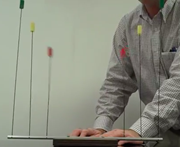 Using a commerical model, The Physics Classroom author quickly demonstrates the concept of a force vibration. Three pairs of inverted pendula are mounted to a metal bar. When one of the pendulum is set into vibrational motion it forces the other pendulum that has the identical frequency to begin vibrating. It is a quick demo for introducing the concepts of natural frequency, forced vibration, and resonance. The model could easily be constructed using dowel rods and wooden spheres.
Using a commerical model, The Physics Classroom author quickly demonstrates the concept of a force vibration. Three pairs of inverted pendula are mounted to a metal bar. When one of the pendulum is set into vibrational motion it forces the other pendulum that has the identical frequency to begin vibrating. It is a quick demo for introducing the concepts of natural frequency, forced vibration, and resonance. The model could easily be constructed using dowel rods and wooden spheres.
- Water Goblet Resonance
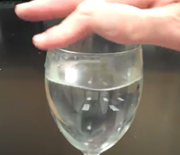 A water goblet is forced to vibrate by running a finger over its rim. The stick-slip friction between the finger and the glass causes the glass to resonate in sync with the slipping and sticking of the finger. This forced vibration produces a distinct pitch. The pitch is then altered by removing water from the goblet, thus altering the speed of vibrations within the glass, and ultimately the frequency of its vibrations. It's an easy and memorable demonstration to perform live with your classes.
A water goblet is forced to vibrate by running a finger over its rim. The stick-slip friction between the finger and the glass causes the glass to resonate in sync with the slipping and sticking of the finger. This forced vibration produces a distinct pitch. The pitch is then altered by removing water from the goblet, thus altering the speed of vibrations within the glass, and ultimately the frequency of its vibrations. It's an easy and memorable demonstration to perform live with your classes.
- Longitudinal Standing Wave in a Spring
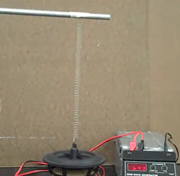 If you have access to a frequency generator and mechanical oscillator, you can set up this demonstration quite quickly. The nearly 3.5-minute describes how to use a vibrating spring to study longitudinal standing waves. The nodes and antinodes are clearly visible; the use of a note card (a.k.a., node card) inserted between coils provides some audio reinforcement of the concept of nodes and antinodes. As the frequency is increased to higher modes of vibration, one observes more nodes and antinodes in the pattern.
If you have access to a frequency generator and mechanical oscillator, you can set up this demonstration quite quickly. The nearly 3.5-minute describes how to use a vibrating spring to study longitudinal standing waves. The nodes and antinodes are clearly visible; the use of a note card (a.k.a., node card) inserted between coils provides some audio reinforcement of the concept of nodes and antinodes. As the frequency is increased to higher modes of vibration, one observes more nodes and antinodes in the pattern.
- Chladni Plates with The Physics Girl
 If you have a frequency generator and a Chladni plate, you can perform this demonstration live for your students. They will not forget it. The Physics Girl does the demonstration and thoroughly explains how it works with her usual excitement and accuracy. If you don't have a frequency generator or if you simply wish to add a little spice to the demonstration, then use a violin bow (what that can get torn up) to force the vibrations of the Chladni plate into resonance as you strum across the edge of the plate. Make sure you add plenty of rosin to the bow and experiment with different strumming locations in order to obtain different patterns.
If you have a frequency generator and a Chladni plate, you can perform this demonstration live for your students. They will not forget it. The Physics Girl does the demonstration and thoroughly explains how it works with her usual excitement and accuracy. If you don't have a frequency generator or if you simply wish to add a little spice to the demonstration, then use a violin bow (what that can get torn up) to force the vibrations of the Chladni plate into resonance as you strum across the edge of the plate. Make sure you add plenty of rosin to the bow and experiment with different strumming locations in order to obtain different patterns.
Minds On Physics Internet Modules:
The Minds On Physics Internet Modules are a collection of interactive questioning modules that target a student’s conceptual understanding. Each question is accompanied by detailed help that addresses the various components of the question.
- Sound and Music, Ass’t SM5 - Resonance and Standing Wave Patterns
- Sound and Music, Ass’t SM8 - Harmonics for Open-End Air Columns
- Sound and Music, Ass’t SM9 - Mathematics for Open-End Air Columns
- Sound and Music, Ass’t SM10 - Harmonics for Closed-End Air Columns
- Sound and Music, Ass’t SM11 - Mathematics for Closed -End Air Columns
Concept Building Exercises:
- The Curriculum Corner, Sound and Music, Resonance
- The Curriculum Corner, Sound and Music, Resonance and Open-End Air Columns
- The Curriculum Corner, Sound and Music, Resonance and Closed-End Air Columns
Problem-Solving Exercises:
- The Calculator Pad, Sound and Music, Problems #21 - #31
Link: http://www.physicsclassroom.com/calcpad/sound
Science Reasoning Activities:
- The Sound of Music
Link: http://www.physicsclassroom.com/reasoning/sound
Cool Stuff Worth Showing:
- Chladni Patterns
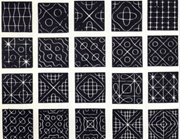 When it comes to the topic of resonance, everybody's favorite demonstration is the standing wave patterns formed on a resonating Chladni Plate. Finding its origin in the studies of 18th century musician and scientist Ernst Chladni, the demonstration is usually performed with sand on a flat square sheet of metal. A violin bow is drawn across one edge of the plate, setting the plate into vibrational motion and forcing the sand to vibrate off of antinodal positions and to settle on the nodal positions. Different patterns emerge depending largely on the tightness of the bow and the location where it is drawn across the metal plate. Visit science writer Joe Hanson's It's OK to Be Smart blog to learn more and to view some videos of the phenomenon.
When it comes to the topic of resonance, everybody's favorite demonstration is the standing wave patterns formed on a resonating Chladni Plate. Finding its origin in the studies of 18th century musician and scientist Ernst Chladni, the demonstration is usually performed with sand on a flat square sheet of metal. A violin bow is drawn across one edge of the plate, setting the plate into vibrational motion and forcing the sand to vibrate off of antinodal positions and to settle on the nodal positions. Different patterns emerge depending largely on the tightness of the bow and the location where it is drawn across the metal plate. Visit science writer Joe Hanson's It's OK to Be Smart blog to learn more and to view some videos of the phenomenon.
Real Life Connections:
- Physics and Acoustics of Baseball and Softball Bats
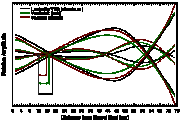 Acoustics professor and researcher Dan Russell has compiled a collection of materials on his website that pertain to vibrations, waves, and sound. One of the more popular sections is the section on baseball and softball bats. Much of Dr. Russell's research is featured there. There are numerous articles that illustrate the importance of resonance, resonance modes, and standing waves to an understanding of the effectiveness of baseball and softball bats. The research has been presented in a manner such that the amateur enthusiast could understand.
Acoustics professor and researcher Dan Russell has compiled a collection of materials on his website that pertain to vibrations, waves, and sound. One of the more popular sections is the section on baseball and softball bats. Much of Dr. Russell's research is featured there. There are numerous articles that illustrate the importance of resonance, resonance modes, and standing waves to an understanding of the effectiveness of baseball and softball bats. The research has been presented in a manner such that the amateur enthusiast could understand.
Standards:
A. Next Generation Science Standards (NGSS)
Disciplinary Core Ideas - Waves and Their Applications
- HS-PS4-1: The wavelength and frequency of a wave are related to one another by the speed of travel of the wave, which depends on the type of wave and the medium through which it is passing.
Crosscutting Concepts
Patterns
- Mathematical representations are needed to identify some patterns.
Cause & Effect:
- Cause and effect relationships can be suggested and predicted for complex natural and human designed systems by examining what is known about smaller scale mechanisms within the system.
Scale, Proportion and Quantity:
- Algebraic thinking is used to examine scientific data and predict the effect of a change in one variable on another (e.g., linear growth vs. exponential growth).
Systems and System Models
- Models (e.g., physical, mathematical, computer models) can be used to simulate systems and interactions—including energy, matter, and information flows—within and between systems at different scales.
- When investigating or describing a system, the boundaries and initial conditions of the system need to be defined and their inputs and outputs analyzed and described using models.
Science and Engineering Practices
Practice #2: Developing and Using Models
- Develop and/or use multiple types of models to provide mechanistic accounts of phenomena
- Develop and/or use a computational model to generate data to support explanations, predict phenomena, and analyze systems.
Practice #3: Planning and Carrying Out Investigations
- Select appropriate tools to collect, record, analyze, and evaluate data.
- Make directional hypotheses that specify what happens to a dependent variable when an independent variable is manipulated.
Practice #4: Analyzing and Interpreting Data
- Apply concepts of statistics and probability (including determining function fits to data, slope, intercept, and correlation coefficient for linear fits) to scientific and engineering questions and problems, using digital tools when feasible.
Practice #5: Using Mathematics and Computational Thinking
- Use mathematical, computational, and/or algorithmic representations of phenomena or design solutions to describe and/or support claims and/or explanations.
- Apply techniques of algebra and functions to represent and solve scientific and engineering problems.
Practice #7: Engaging in Argument from Evidence
- Make and defend a claim based on evidence about the natural world or the effectiveness of a design solution that reflects scientific knowledge and student-generated evidence.